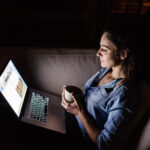 It is thought that the majority of us spend 90% of our time indoors and we spend a significant portion of our waking hours in front of personal devices with digital screens that are lit up by LEDs or light-emitting diodes. The light that is emitted by LEDs appears white but actually has a spectral distribution that peaks in the blue portion of the electromagnetic spectrum.
It is thought that the majority of us spend 90% of our time indoors and we spend a significant portion of our waking hours in front of personal devices with digital screens that are lit up by LEDs or light-emitting diodes. The light that is emitted by LEDs appears white but actually has a spectral distribution that peaks in the blue portion of the electromagnetic spectrum.
[Wong NA, Bahmani H. A review of the current state of research on artificial blue light safety as it applies to digital devices. Heliyon 2022;8(8): e10282. doi: 10.1016/j.heliyon.2022.e10282]
So what?
Well, it is well known that UV radiation is the main cause of skin or photoageing. It is also increasingly known that visible light with a wavelength of 400-700 nm, alongside UVA radiation is the main contributor to photoageing. However, more specifically, it is high energy visible (HEV) light, or blue light with a wavelength of 400-500 nm which causes hyperpigmentation in skin.
[Duteil L, Cardot-Leccia N, Queille-Roussel C et al. Differences in visible light-induced pigmentation according to wavelengths: a clinical and histological study in comparison with UVB exposure. Pigment Cell Melanoma Res 2014;27:822-826.]
How does blue light exposure do that?
Blue light has been shown to cause oxidative stress and increased pigmentation in the skin by the formation of reactive oxygen species (ROS) and activation of melanogenesis (making melanin, the compound that causes pigmentation).
[Campiche, R, Curpen SJ, Lutchmanen-Kolanthan V et al. Pigmentation effects of blue light irradiation on skin and how to protect against them. Int J Cosmetic Sci 2020;42:399-406.]
[Li L, Jiang X, Tu Y et al. Impact of blue light on skin pigmentation in patients with melasma. Skin Res Tech 2023; 29(7): 313401. Doi: 10.1111/srt.13401.]
So my phone and laptop could be causing photoageing and hyperpigmentation?
Well, there is no definite proof that a phone or a laptop could be the sole cause of photoageing and pigmentation. The main source of blue light is still the sun. But smartphones, computer screens, televisions, smartwatches, indoor lighting all use LEDs as they are highly efficient, compact and have an extended lifespan. The worry is that as the use of LEDs becomes more widespread, there may be long-term consequences of being exposed to these ever increasing amounts of blue light.
What do we know?
We do know that blue light has effects on the eye, namely the retina and it can also disturb the circadian rhythm by suppressing melatonin levels.
What can be done to prevent the effects of blue light?
The best treatment is always prevention.
For the eyes, it is to reduce screen time, invest in blue light screen filters for your devices. There is possibly some benefit for wearing blue light-blocking eyewear.
Observe the 20-20-20 rule: spend 20min looking at a screen, then 20 seconds looking at something 20 feet away.
[Kumari J, Das K, Babaei M et al. The impact of blue light and digital screens on the skin. J Cosmetic Dermatol 2022;22:1185-1190.]
For your circadian rhythm, switch your devices to ‘night mode’ to reduce the amount of blue light being emitted. Stop looking at devices at least an hour before bedtime.
And for the skin?
The treatment of hyperpigmentated conditions such as melasma is renownedly difficult and requires persistence.
Daily, life-long wearing of sunscreen is vital. The use of tinted sunscreens to block visible light is key. There are now sunscreens that contain products that can counteract pigmentation such as niacinamide or contain products that can also block melanogenesis such as thiamidol, tranexamic acid or azelaic acid. There are also new sunscreen filters that can provide photoprotection in the HEV or blue light range such as phenylene bis-diphenyltriazine (PBDT or TriAsorBTM).
[Boyer F, Delsol C, Ribet V et al. Broad-spectrum sunscreens containing the TriAsorBTM filter: In vitro photoprotection and clinical evaluation of blue light-induced skin pigmentation. J Eur Acad Dermatol Venereol. 2023;37(Suppl.6):12-21.]
Or we could all put down our devices, turn off the telly and spend more time enjoying the company of those around us.
Kind regards,
Sandy
Dr Sandy Flann, Consultant Dermatologist
